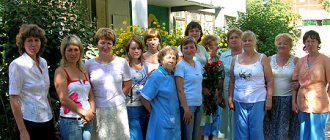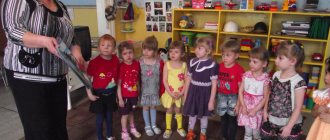Speech at the parent meeting “Features of a group of young children”
NATALIA ANDRIANOVA
Speech at the parent meeting “Features of a group of young children”
Good evening, dear parents ! We are glad to see you at our parent meeting .
Our meeting today is dedicated to “ Features of the group of children in our group ”
.
Enrolling a child in kindergarten is the first step into independent life, which is not easy for all children. The social environment in kindergarten is the opposite of home. At home, the child is placed on a pedestal. The family's life revolves around him. And in kindergarten he is the same as everyone else. He is part of a group , and often he does not know how to behave. Children are still just learning to communicate with their peers. Our task is to help them become not only independent individuals, but also to help them socialize in their still small community, to become a team .
The great Soviet teacher A. S. Makarenko emphasized the role of the team in shaping the child’s personality and his relationships with other members of the team . The main thing, he believed, in a team is that each child is an active unit, without losing his individuality, and all participants carry out joint activities, set new goals that unite them, in the process of this they grow as individuals, because new tasks require a new level of communication, self-development, and the general mood improves. The child persistently seeks and finds his place in the team , his status, albeit childish, but no less important for this, realizes himself, and, of course, grows as a person.
The team is a great educational force, believed V. A. Sukhomlinsky.
Until the age of 2-3 years, a child does not experience an urgent need to communicate with peers; it has not yet formed. At this age, an adult acts as a play partner for the child, a role model, and satisfies the child’s need for friendly attention and cooperation. Peers cannot give this, because they themselves need the same.
After 2-2.5 years, the child understands that there are the same children around, and not big screaming dolls. He begins to compare himself with his peers and draw his own conclusions. It is important for a child to stand out, to receive the approval of peers and the praise of the teacher, if he can do something better than others. If a child fails to fit in with his peers, he may either withdraw into himself or become overly aggressive. Closedness and aggressiveness at this age are a consequence of the fact that the child feels that in some way he does not correspond to his peers. Do not punish a child if he is excessively pugnacious. The kid doesn’t understand why you’re scolding him: why the doll can be pulled by the hair, but Olya can’t. For him, Olya is also a kind of doll, only a larger one, and he wonders how she will react to his actions. Time will pass, and the child will learn to understand the difference between animate and inanimate objects. Our task is to explain to the child that other people, regardless of age , can also experience pain, fear, and resentment. To do this, when playing with a child, there is no need to endure, if he hurts you, explain to the child your feelings and the feelings of others.
As a teacher, I understand that the children’s team needs constant work to unite and form children’s friendships, but parents also need to pay attention to this at home. Unfortunately, often parents , guided by their own not always positive experience in this area, set up their children according to the principle “Everyone for himself”
. This position is deeply mistaken. A child who does not know how to empathize, sympathize, and is fixated on himself will subsequently experience difficulties and will not be able to be either successful or, most importantly, happy.
Outside the children's team , the harmonious all-round development of the child is impossible, and with skillful leadership, the team not only does not limit the growth of the individual, but, on the contrary, helps him.
In conclusion, I would like to say that together we will lay the foundation of friendly relations in children's and parent teams , as well as in relations between parents and teachers of a preschool institution. We need to make sure that the child in kindergarten has fun, good, and interesting, so that he goes to kindergarten with joy, makes friends with the kids and returns home happy, because loving adults are waiting for him at home.
Our parent meeting is coming to an end , I thank you, dear parents , for taking the time to visit us. In the future, I will be glad to see you as our guest at thematic meetings and meetings .
From the experience of a senior teacher. Parents' meeting at the preschool educational institution
How to properly organize a parent meeting at a preschool educational institution?
The preschool teacher communicates daily with children and parents, sees their problems, difficulties, as well as the positive experiences of each family. One of the tasks of communication between a teacher and parents is to reveal to parents important aspects of the child’s mental development and help them build the right pedagogical strategy. In resolving these issues, parent meetings are indispensable, as they are an effective form of communication between educators and parents. However, parents are busy people; sometimes they don’t have time to talk to the teacher, come to a meeting, or they think that they already know everything about their child. In this case, the teacher must know how to interest parents in the necessary pedagogical information, and then how to effectively organize a parent meeting.
Parent meeting It is at meetings that the teacher has the opportunity to familiarize parents with the tasks, content, and methods of raising preschool children in a kindergarten and family setting. During the meeting, the main burden falls on the report. This material can be used for conducting oral and written consultations with parents, as well as other forms of work. The teacher is required to have a creative approach to the material: searching for new examples; using their own methods of activating parents, aimed at making listeners interested in the problem being studied, at creating associations with their own experience of raising children, and at rethinking their parental position. In this case, it is necessary to take into account the parents’ need for knowledge. • psychological training; • Master Class; • joint activities between children and parents; • Open Day; • screening of theatrical productions. Preparing a parent meeting 1. A week before the meeting, you can conduct a survey of parents on the topic of the meeting. Questionnaires are filled out at home before the meeting and their results are used during the meeting. 2. To activate parents and ensure their attendance at the meeting, it is advisable to make invitations to each family in the form of applications, designs, taking into account the theme of the meeting. It is important that children take part in making secret invitations for parents. Invitations are distributed a week before the meeting. 3. In accordance with the theme of the meeting, create original leaflets with tips. The content of the memos should be brief, the text should be printed in large font. 4. Our kindergarten uses such forms of attracting parents to parent-teacher meetings as: preparing competitions, exhibitions, and crafts on the theme of the meeting. At the same time, both children and their parents participate in competitions. All prepared works are exhibited before the meeting, and the teacher introduces parents to samples of work. At the meeting itself, parents choose the best work, and the winner is awarded a prize. 5. An audio recording of children’s answers to questions on the topic of the meeting can be used as one of the forms of activating parental attention. 6. Occasionally invite a fairy-tale character to a meeting. 7. We attract the attention of parents to the meeting by creating homemade posters on the topic of the meeting. 8. It is advisable to hold parent committee meetings a month before the meeting. Immediately before the meeting, it is necessary to:
• prepare furniture on which it would be comfortable for parents to sit.
You can arrange tables and chairs in a circle, put cards on them with the names and patronymics of parents, • prepare pens and sheets of paper so that they can write down the information they are interested in, as well as pencils, children’s work on modeling, drawing, and appliqué. • consider who will provide child care during the meeting and how. Conducting a parent meeting A parent meeting traditionally consists of 3 parts: introductory, main and “miscellaneous”.
The meeting time is 1 hour. (40 minutes with parents and 20 minutes with children). 1.
The introductory part
is designed to organize parents, create an atmosphere of goodwill and trust, concentrate their attention, and motivate them to solve problems together.
This can be done by communicating the topic, the form of the meeting, or through short games and activities. You can create a certain musical background: the sounds of a guitar, piano, tape recording, which will accompany the words of the presenter. 2. The main part
of the meeting can be divided into two or three stages.
As a rule, this part begins with a speech by the group teacher, senior teacher or other preschool specialists, covering the theoretical aspects of the problem under consideration. The message should be short, since by the end of the working day the stability of attention decreases. The main thing is that parents are not just passive listeners. It is necessary to ask questions to the listeners, give examples from the practice of raising children in families and kindergartens, analyze pedagogical situations, offer parents to watch video clips of classes with children, games, walks, etc. You should not reproach or lecture your parents. More often you need to use moments from the lives of children in the group as examples. When talking about unwanted actions of children, there is no need to mention their last names. During their communication, teachers should avoid making claims against parents and children, discussing the personality of a particular child; One should not state the failures of children, the main thing is to jointly develop ways to solve the problems under discussion. It is better to have a conversation in soft lighting. Transitions from one situation to another can be separated by a short musical pause. If possible, it is better to stage the situations being analyzed. To illustrate your ideas and considerations, you can use tape and video recordings, photographs and interviews of children in the group, diagrams and graphs, visually presented theses and speeches. All this will contribute to a better understanding of the theme of the meeting. When conducting this part of the meeting, you can also use the following methods: lecture, discussion, conference, which can also be separate forms of work with the families of pupils. 3. In the third part of the parent meeting - “miscellaneous”
- issues of maintaining a child in kindergarten, leisure activities, and organizing joint events between the family and the preschool educational institution are discussed. It is recommended to think through in advance several options for solving the problem that will be offered to parents for discussion, agree with those of them who can help, take responsibility, etc. Some issues need to be resolved in advance with the parent committee. At the end of the meeting, it is necessary to summarize the meeting, listing the decisions made on each of the issues discussed, recorded in the minutes. Meetings can be held in the form of question-and-answer evenings, oral journals, talk shows, etc. Despite the differences in these forms, they are united by one meaning - to give parents knowledge about raising their own child, to interest them in the problems of education, and to stimulate them to reconsider their educational position.
Download How to properly organize a parent meeting in a preschool educational institution?
We recommend watching:
Parent meeting in the senior group of the kindergarten Pedagogical council in the kindergarten on the topic: Artistic and aesthetic development of preschoolers Methodology room in the kindergarten in accordance with the Federal State Educational Standard Self-education of a preschool teacher in accordance with the Federal State Educational Standard
Similar articles:
Parent meeting in kindergarten. My child
Summary of the parent meeting in the first junior group
Summary of the final parent meeting in the second junior group
Scenario for a parent meeting in the senior group “The role of home and family in shaping the personality of a preschooler”
Summary of the parent meeting in kindergarten “My Safe Way Home”




